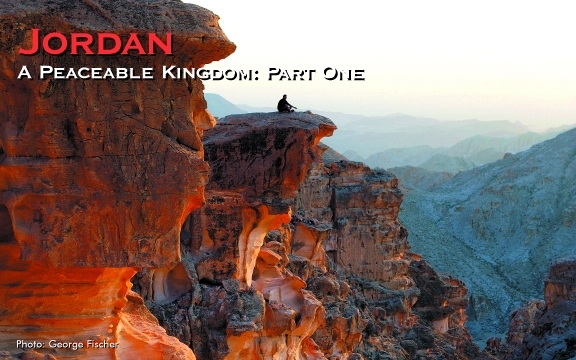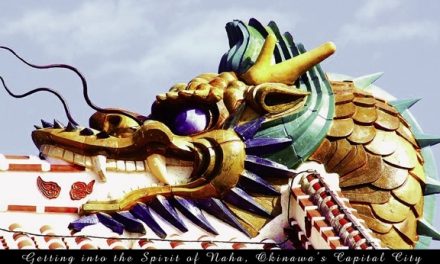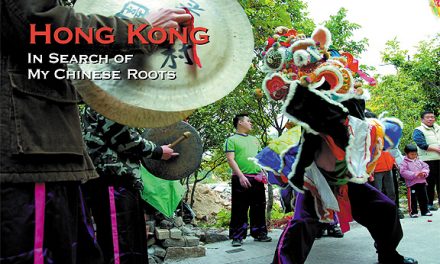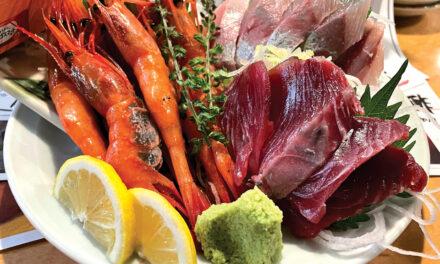Jordan
A Peaceable Kingdom – Part 1
Published in the Winter 2007-08 Issue of Canadian World Traveller
By Greg James
Photos: Jordan Tourism Board, George Fischer and other accredited photographers
The last thing my Mum said to me before I left on my trip to Jordan was that I should be careful and that she would pray for my safe return. Like most people, all she knew about this relatively small country was that it was located somewhere in the often-tumultuous Middle East.
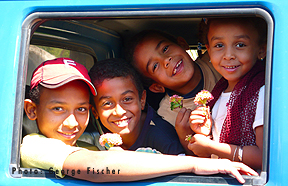 But on the ride from Amman’s Queen Alia International Airport to our downtown hotel, our affable local guide was quick to reassure us that the Hashemite Kingdom of Jordan is an oasis of peace, security and serenity, even if located in a really tough neighbourhood!
But on the ride from Amman’s Queen Alia International Airport to our downtown hotel, our affable local guide was quick to reassure us that the Hashemite Kingdom of Jordan is an oasis of peace, security and serenity, even if located in a really tough neighbourhood!
Over the next ten days of my “Royal Tour” of the Kingdom, I found this to be patently true. As it turned out, my Mum had absolutely nothing to be worried about!
Jordan shares its borders with Syria to the north, Iraq to the east, Saudi Arabia to the south and Israel and the Palestinian West Bank Territory to the west, but this breathtakingly beautiful country is indeed a peaceable kingdom that should be on the must-see-list of every world traveller.
Our tour would take us from the pine forests and olive groves of Jordan’s northern regions to its southern tip, where the fabled port city of Aqaba proudly stands at the head waters of the biblical Red Sea. However, beyond any doubt, the highpoint of my trip had to be the rose-red rock city of Petra, a site that is truly worthy of being chosen as one of the New Seven Wonders of the World!
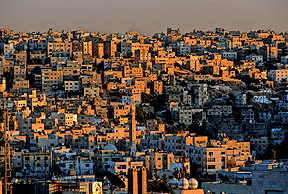
Inaugural Flight
I was fortunate to be travelling on Royal Jordanian Airlines‘ inaugural direct flight from Montreal’s Trudeau International Airport to the Jordanian capital of Amman. My good luck doubled when I was informed at the boarding gate that I had been bumped up to first class. My extra-wide seat extended to become a comfortable airborne bed.
This made the 11-hour, non-stop flight seem half as long and I soon found myself gazing out of my window at the flat desert-like terrain flashing by on either side of the runway.
On arrival at the downtown Radisson SAS Hotel Amman, which would be home during our two-night stay in Amman, I was a bit startled to discover a security checkpoint at the entrance of the five-star hotel. Apparently, this is a precaution taken by most large hotels in the Middle East. The security personnel turned out to be quite friendly and the checks soon became routine and reassuring.
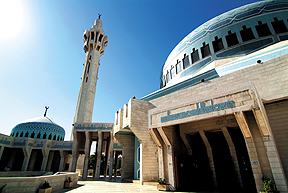 Memorable City Tour
Memorable City Tour
Revitalized by a brief rest in our well-appointed rooms, we embarked on an ambitious tour of Amman with a visit to the King Abdullah Mosque.
Although Jordan could never be described as being fanatically Muslim, the women in our group were each asked to don a hooded, floor-length gown (an abaya) and we were all asked to remove our shoes as a sign of respect before entering the building.
The impressive blue-domed mosque, completed in 1990, is a fitting memorial to the grandfather of the late King Hussein and great grandfather of Jordan’s current monarch, King Abdullah II.
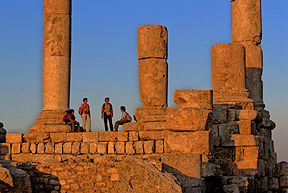 The Citadel
The Citadel
After a delightful lunch at the Romero, Amman’s premier Italian restaurant, we headed for the Citadel. Towering above downtown Amman, this is the site of the city’s earliest fortifications.
Over the years, it has been excavated to reveal remains that date back to the Middle Bronze Age! The soaring columns of an early Roman temple and the ruins of a small Byzantine basilica dominate this historic site.
The Citadel is also the site of Jordan’s small but fascinating Archaeology Museum where some of the famous Dead Sea Scrolls and other priceless artefacts are displayed. This was quite the introduction to the country’s rich historic legacy!
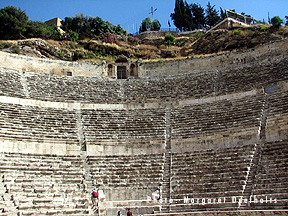 Out and About in Amman
Out and About in Amman
On our tour of the city’s neighbourhoods, we stopped at the remarkable Roman Amphitheatre that was carved out of the side of a hill around 190 A.D. Its 33 rows once seated 5000 spectators.
Today it is right in the heart of downtown Amman and serves as a dramatic concert venue.
Rooms at either side of the amphitheatre house Jordan’s Folklore Museum and Museum of Popular Tradition.
These two museums give the visitor a taste of early Jordanian life through their life-sized tableaux and their displays of fine antique jewellery and intricate handicrafts from bygone eras.
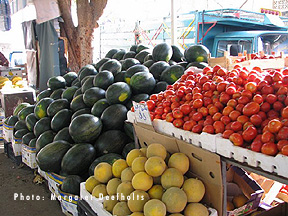 The Amman Suq
The Amman Suq
We finally wound down our city tour with a walk through Amman’s colourful downtown suq. A suq (or souk) is a typical Middle-Eastern open-air market, where you can buy almost anything, from gold chains to aromatic spices.
The suq is also an interesting cultural experience, as I found out when several of its young male vendors asked me in their limited English where I was from.
When I replied that I was from Canada, each of them shouted, “You’re welcome!” One of them even offered me a glass of hot sweetened mint tea. When I tried to pay for it, he refused my Dinar, and exchanging with me the universally recognized hi-five greeting, exclaimed with a broad smile, “Hospitality!”
Some Enchanted Evening
That evening, we dined at Kan Zaman, a village-like emporium located on the outskirts of Amman. The main attraction of the complex was its huge buffet-style restaurant, which featured domed stone ceilings and a central circular open spit offering an array of delectable Arabic dishes.
The complex’ winding cobblestone laneways were lined with handicraft shops including a rather unique establishment festooned with Bedouin tents where one female member of our group had her picture taken, dressed from head to toe in a genuine Bedouin outfit!
Hubble-bubble Pipe
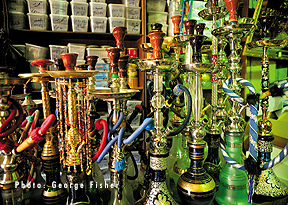 This was also the night that I was introduced to the art and etiquette of smoking a hookah pipe, also called a hubble-bubble pipe.
This was also the night that I was introduced to the art and etiquette of smoking a hookah pipe, also called a hubble-bubble pipe.
Two or more imbibers would take turns, each using a personal plastic mouthpiece (supplied by the establishment), which they would attach to the pipe’s colourful flexible tube.
Unlike other forms of smoking, this activity is considered to be a highly social activity between male friends or acquaintances in many Arab countries. That didn’t stop several of the women in our group from having a go at it!
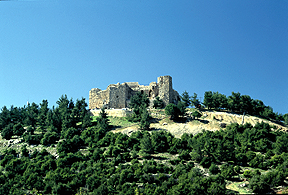
Ajloun: Repelling the Crusaders
Early on the following day, we travelled 73 kilometres north of Amman to visit the hilltop castle of Ajloun.
It was built in 1184 by Saladin’s nephew, who subsequently defeated the Christian Crusaders in 1189.
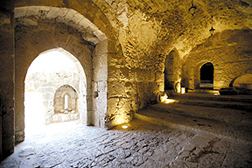
It took a steep, winding road to get to this almost impenetrable stone fortress, which is a superb example of early Arab and Islamic architecture.
The castle towers over the surrounding pine-covered valley and climbing to its highest point was worth the effort, if only for its stunning vistas.
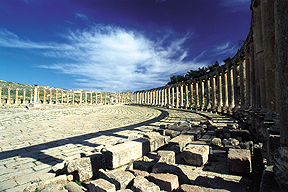
Jerash: Say it in Seven Languages
Driving south, we came to the ancient city of Jerash, often referred to as “the Crossroads of Civilization”. Remains from Neolithic times, as well as Greek, Roman, Byzantine, and Omayyad civilizations are all found here.
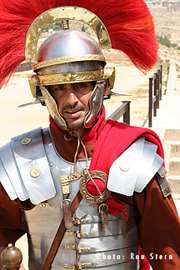
Jerash’s Golden Age arrived with Roman rule. The immense site of the ruins of the Roman city is beyond belief. We were greeted by brawny Jordanian army vets, playing the roles of Roman centurions, then witnessed exciting re-enactments of chariot races and gladiator fights.
Later, we strode between soaring columns and walked down monumental steps built by the Romans to withstand the test of time.
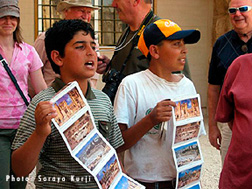
But the most memorable moment came when a charming young postcard vendor, who couldn’t be more than ten years old, rattled off his sales pitch in seven languages, including Japanese!
After that performance, I just had to buy a postcard!
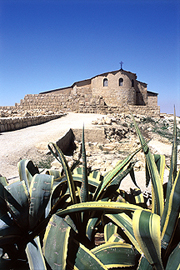 Mount Nebo: A View of the Promised Land
Mount Nebo: A View of the Promised Land
On the following day, we headed for Mount Nebo. As anyone who has seen Cecil B. DeMille’s epic movie “The Ten Commandments” will recall, this is the mountaintop from which an aged Moses saw the Promised Land that he was not allowed to enter.
It was from this vantage point that he watched his followers, who had been freed from bondage in Egypt, as they finally crossed the River Jordan into what is now Israel.
Moses is said to be buried here and a 4th-Century basilica church built to honour him, houses one of the most magnificent mosaic floors in the world. In 2000, the late Pope John Paul II visited the site during his pilgrimage to the Holy Land.
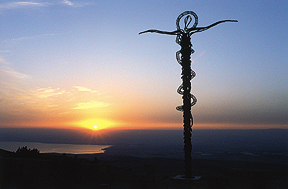
The view from the summit provides visitors with a panorama of much of the Holy Land and the River Jordan Valley.
Unfortunately, it was a bit hazy during our visit, but on a clear day the West Bank city of Jericho and Jerusalem itself are both visible.
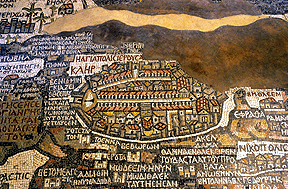
Madaba: City of Mosaics
The next stop on our odyssey was Madaba, famed for its historic mosaics.
The floor of the Greek Orthodox Church of St. George features a vivid, almost totally intact sixth-century Byzantine mosaic map showing Jerusalem and other holy sites in remarkably accurate detail.
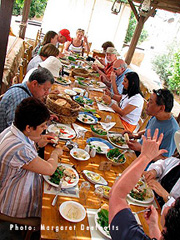
Our knowledgeable guide explained to us that the Dead Sea as shown on the map had shrunk quite a bit by evaporation since the creation of the mosaic.
After a delicious lunch of typical Jordanian fare served with customary local aplomb on long tables under the leafy rooftop arbours of the charming Haret Jdoudna Restaurant, we were on the road again to visit the remarkable Kerak Fortress.
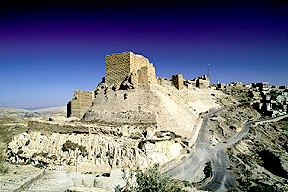
Kerak: Crusaders’ Masterpiece
We travelled southward along the 5,000-year-old King’s Highway to get to the most important remains of Crusader forts and outposts.
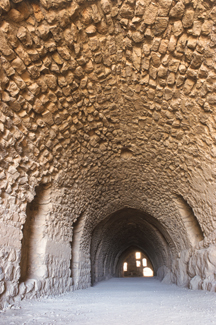
The magnificent Kerak Fortress, built high atop a promontory, is a maze of stone-vaulted halls and endless passageways. The fort, built in 1142, is more imposing than beautiful and stands as an impressive example of the Crusaders’ architectural and military genius.
Once again, as imposing as this historic landmark was, it was its stupendous views of the valleys and hills far below its ramparts that I found truly spellbinding.
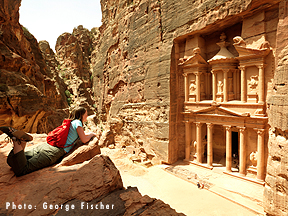
Petra: New Wonder of the World!
Checking into the luxurious Mövenpick Resort Petra, it was hard to imagine that the locale for the climatic scene in “Indiana Jones and the Last Crusade” was literally just down the road.
Jordan abounds in archaeological riches, but few sites in the world can rival the Nabataean city of Petra, which was carved out of rose-red rock cliffs! Little is known about the Nabateans who settled the area more than 2,000 years ago.
Today, some Bedouins make the fabled site their home. One of these friendly desert people, whom I met on one of my solitary climbs of Petra’s challenging uphill paths, even claimed that he was born in one of the many ancient tombs carved into Petra’s steep cliff-sides!
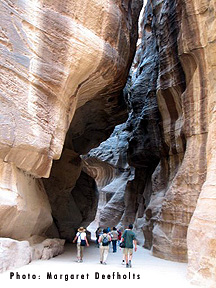
The Siq
We began our amazing tour by hiking along the rocky road that led us to the entrance of the Siq, the two-kilometre-long chasm leading into the heart of Petra.
The Siq is a great cleft in the earth, formed by ancient earthquakes and smoothened for eons by water and wind. This narrow, winding route through towering cliffs protected the site from marauding invaders.
Turning the last bend in the Siq, we came face to face with Petra’s most famous monument, the Treasury. It was dramatically lit by the rays of the sun that penetrated into the deep flat-floored valley.
Originally carved out of the cliff face as a royal tomb, probably between 100 BC and 200 AD, this world-renown edifice remains remarkably intact and stunning beyond words.
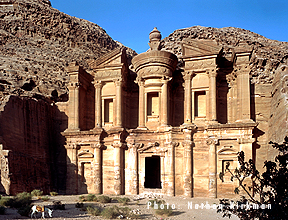
The Monastery
Describing the rest of Petra’s overwhelming archaeological riches would require an entire book. But I highly recommend the hike uphill to the Monastery, which took about an hour each way.
The path continues a short distance past the Monastery, rising to an incredible vantage point over the entire Petra valley. Attaining this view is a truly breathtaking, almost religious experience!
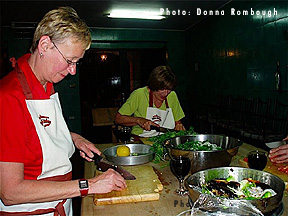
The Petra Kitchen
That night we partook in a very unique culinary experience. We would help to prepare our own supper!
The fresh ingredients for the planned menu of regional dishes were laid out on rows of long, waist-high tables.
We donned our crisp white aprons and were assigned to one of the tables. With knives and glasses of wine in hand and the help of the amicable chef and several female cooks, we proceeded to make quite an impressive multi-coursed meal!
The Petra Kitchen even provided us with printed recipes so we could practise our newly acquired skills at home. As an added bonus, we met Marguerite van Geldermalsen, author of the fascinating autobiographical book “Married to a Bedouin”, who was visiting the Kitchen that night.
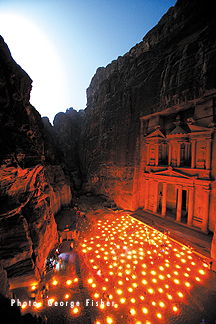
Petra by Night
If there is only one thing you do on an evening spent in Petra, this is it. When I fist heard about it, I thought that “Petra by Night” would be a tour of the city’s nightspots!
How wrong could I be? In fact, it was a magical after-dusk tour on which we retraced our steps back through the narrow, winding Siq. Except now it was illuminated by the ghostly, flickering light of 1,800 candles placed in paper bags all along the route.
When we arrived at the Treasury, the area in front of it had been transformed into a sea of glowing lights. We were invited to sit on the long rugs that were placed between the candles.
Once everyone was seated, the still night air was broken by the plaintive strains of the traditional instruments of two local performers. What a fitting end to our Petra visit!
Little Petra
After a short visit at the Little Petra, which was used by the Nabateans as a marketplace more than 2,000 years ago, we were on our way to spend a night in a Bedouin camp in the middle of the desert!
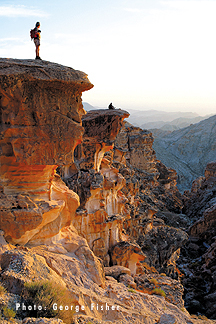
Jordan Odyssey Continued
We invite you to join us in Part 2 of our Jordanian odyssey published in our Spring 2008 Issue, in which we visit Wadi Rum, the largest and most magnificent of Jordan’s deserts.
Next on the agenda is a brief sojourn in the Red Sea resort town of Aqaba, made famous by Lawrence of Arabia, then a tour of Bethany Beyond the Jordan, to walk on the bank of the very spot in the river where John baptized Jesus Christ.
Last but not least, we spend two days at the incredibly luxurious spa resorts on the shore of the Dead Sea, the lowest point on earth, where try as you might, you can’t sink in this amazing, health-giving, 30-percent-saline body of water!
Getting There:
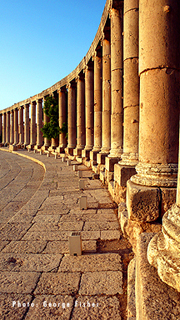 Royal Jordanian Airlines
Royal Jordanian Airlines
1801, McGill College Ave, Suite 940
Montréal, QC H3A 2N4
Tel: 514-288-1647 Toll-free: 1-800-363-0711
Email: YULTBRJ@rj.com
Website: www.rj.com
Where to Stay:
Radisson SAS Hotel Amman
Website: www.radissonsas.com
Mövenpick Resort Petra
Website: www.moevenpick-hotels.com/en/pub/your_hotels/
worldmap/petra/overview.cfm
For More Info:
Jordan Tourism Board North America
6867 Elm Street, Suite 102
McLean, VA 22101
Tel.: 703-243-7404/5
Toll-free: 1-877-seejordan (733-5673)
Fax: 703-243-7406
Email: info@seejordan.org
Website: www.visitjordan.com

